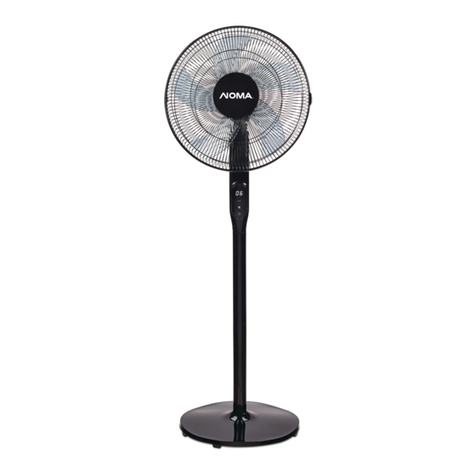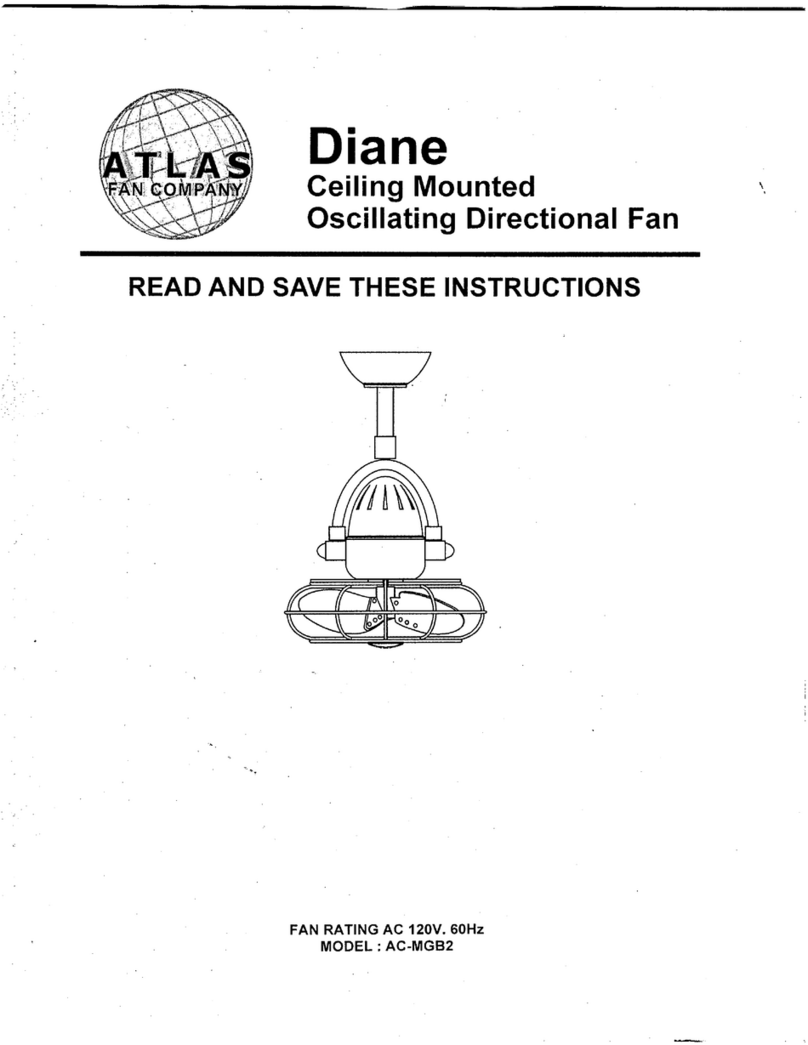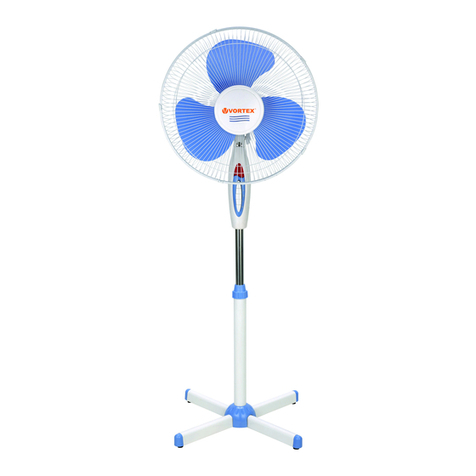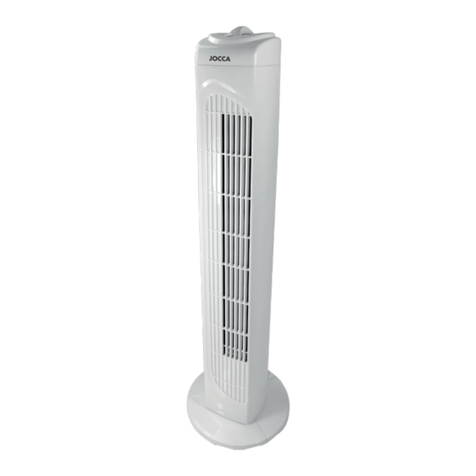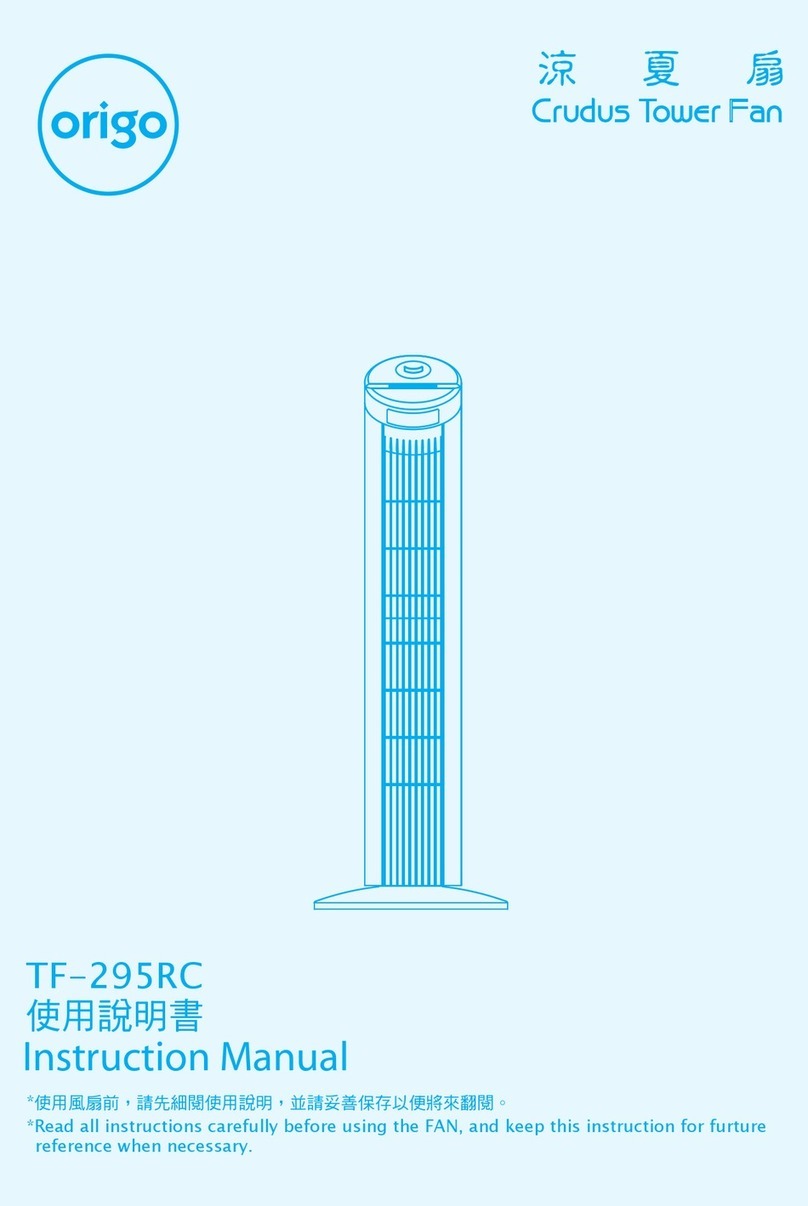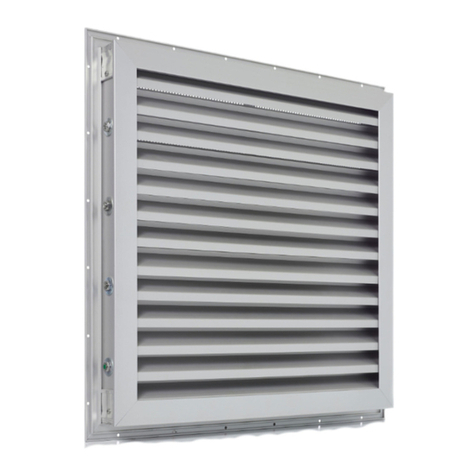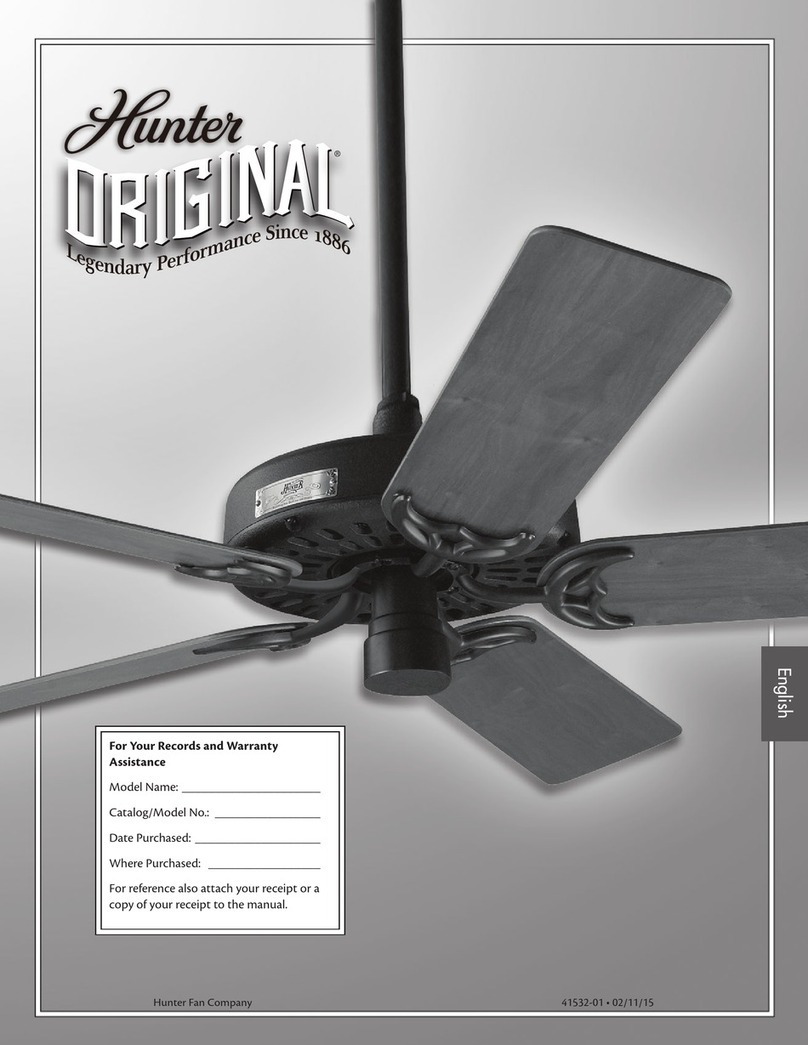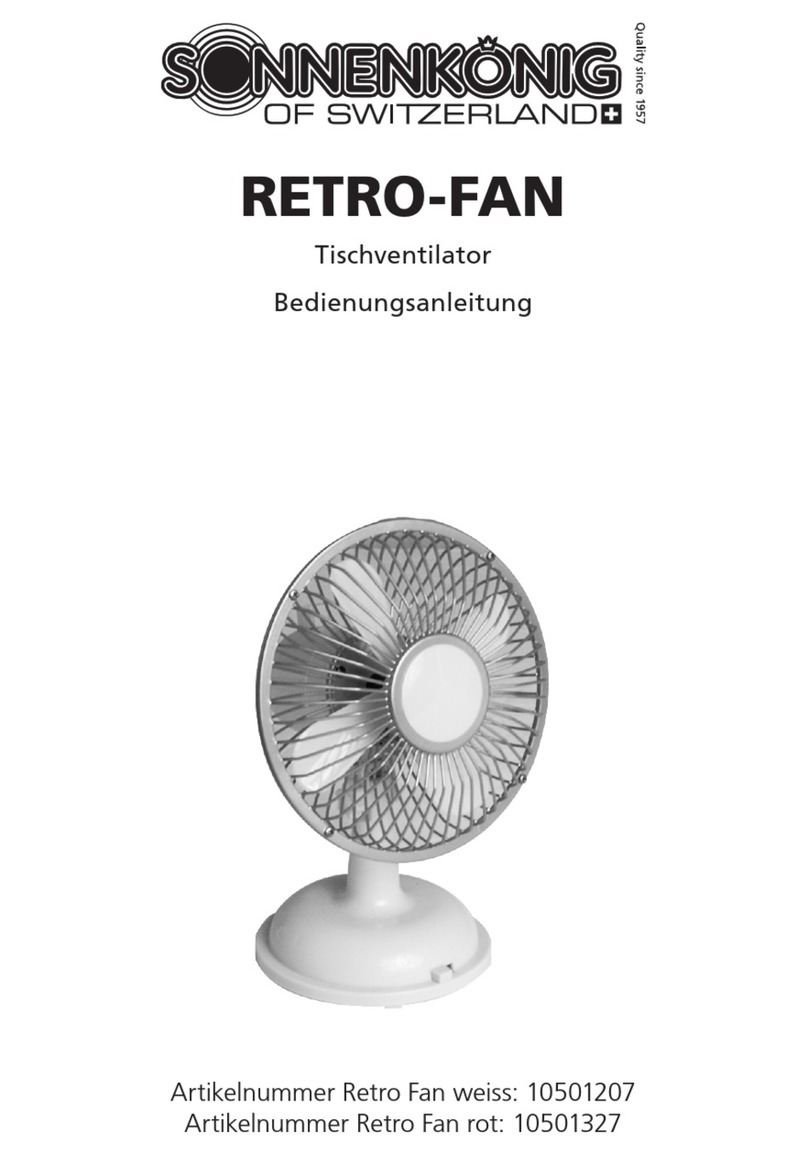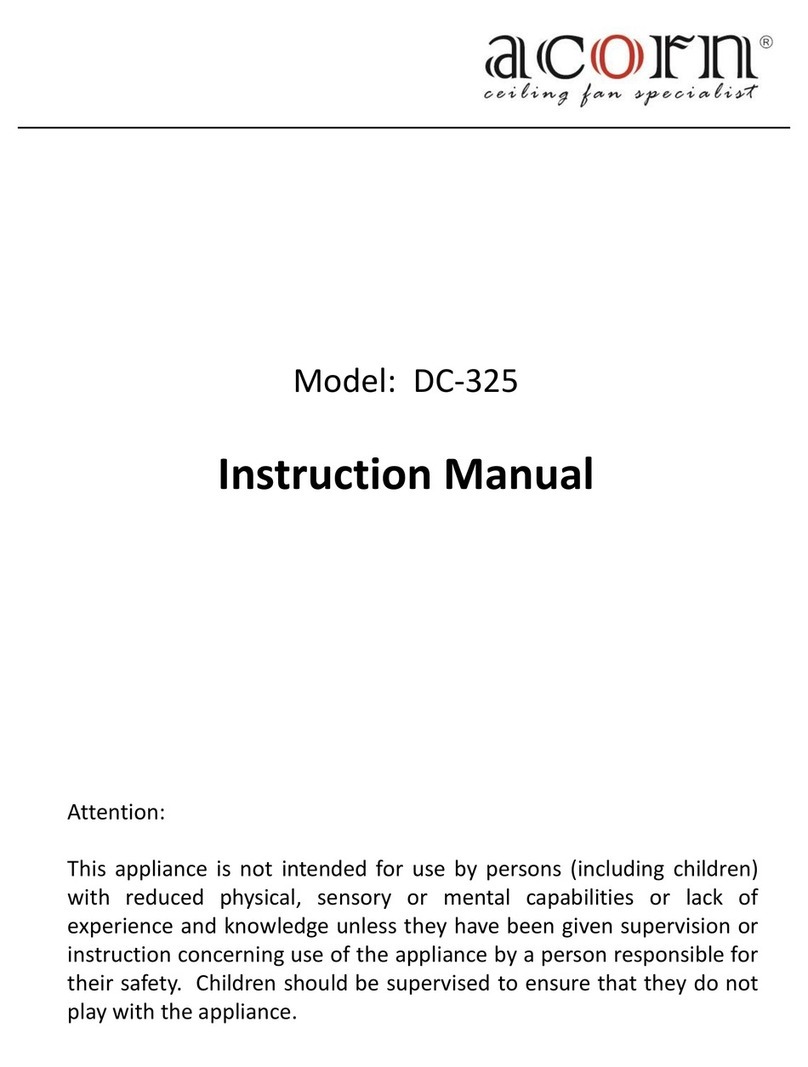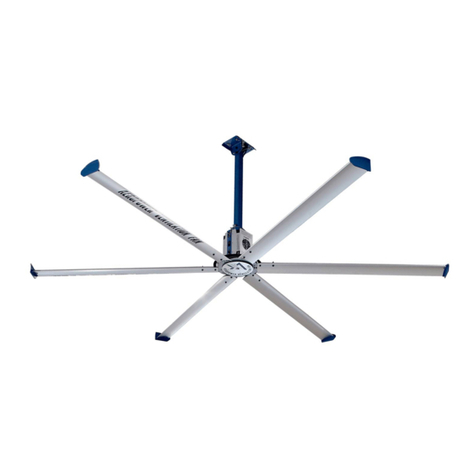Prunus Boaray 5000C User manual

I
Product Information
Product Name: Ventilator
Product Model: Boaray 5000C, Boaray 5000D
Version Information
The version number ofthis user manual may be updated due to the software
upgrades, Shenzhen Prunus Medical Co., Ltd. reserves the right to change it without
giving prior notice.
The version information:
Version No.: M93-P-00040-15.0
Release date: May 2019

II
CE Mark
WELLKANG LTD ( WWW.CE-MARKING.EU ) Suite B ,29 Harley Street
LONDON W1G 9QR ,England ,United Kingdom
The product is marked with CE, as it conforms to European Council Directive for Medical
Devices (93/42/EEC), and meets basic requirements of appendixⅠin the directive.
This product is the TypeⅠ,Class B radio jamming protective equipment that complies with
the EN55011. It meets the requirements of EN60601-1-2 standard “Medical electrical
equipment - Part 1-2: General requirements for basic safety and essential performance -
Collateral Standard: Electromagnetic disturbances - Requirements and tests”.
Declaration
The intellectual property of the product and its document belongs to Shenzhen Prunus
Medical Co., Ltd. (hereinafter referred to as the Company). The Company reserves the
final right of interpretation for this document. Any unauthorized copying, storage,
reproduction or translation of this document in any form is strictly prohibited without the
prior written permission from the Company.
Users can, if need, ask for other technical information separately from the Company in
order to understand, operate and maintenance the equipment, but should ensure the
information not obtained by the third party.

III
User responsibility
Please check the product and accessories firstly when you receive the product, make sure
it conforms to the contract. If any damage to the package or the product is found before or
after opening the packing case, please contact the local office or the franchiser
immediately.
Users must perform the installation, operation, maintenance and carry out regular
inspection according to the instruction described in the manual. Replace the components
immediately if any damage, loss, distortion or contamination is found. Stop use when
malfunction occurs. Please contact the after service department of the Company for
repairing and replacing. Any change of the product is verboten without agreement from the
Company. The user must take responsibility for any malfunction which results from
non-compliance with the servicing requirements detailed in this manual or the service or
repairs are not performed by the personnel of the Company.
Free Maintenance
The user reserves the right to be served for free repairs and replacement within 12 months
from the order delivered date only in the event that the product is purchased from the
Company or the authorized distributor, it must be new product when purchased and it is
operated according to the “User Responsibility”. Otherwise, the Company has no
responsibility for any damages to the product.
Trademarks
, and are trademarks or registered
trademarks of the Company.

IV
Preface
Description
This manual describes the intended use, function, installation, operation and maintenance
of the product. Personnel must make themselves familiar with the contents of this manual
and the machine’s function before using the product. When you begin to use the ventilator,
we consider that you have read the manual carefully.
In order to use the equipment accurately, effectively and avoid the accident, please read
the manual carefully and comply with it strictly, especially pay attention to the “Warning”,
“Caution” and “Note”.
The optional features may not be completely included in the manual, should you have any
questions, please contact the Company.
Please put the manual near the product so that you can easily fetch it at any time.
Illustration
The illustrations in the manual are only for reference, some settings and data may not be
consistent with the real display of the product; please refer to the real product.
Conventions
Bold Italic: The quoted section.
【
Character
】
:The character string on the software interface or in the control
panel.

V
Contents
PRODUCT INFORMATION ......................................................................................................... I
AFTER SERVICE......................................................................................................................... I
VERSION INFORMATION........................................................................................................... I
CE MARK.................................................................................................................................... II
DECLARATION........................................................................................................................... II
USER RESPONSIBILITY .......................................................................................................... III
FREE MAINTENANCE .............................................................................................................. III
TRADEMARKS.......................................................................................................................... III
PREFACE...................................................................................................................................IV
CONTENTS.................................................................................................................................V
1 SAFETY INFORMATION ......................................................................................................... 1
1.1 WARNINGS..................................................................................................................... 2
1.2 CAUTIONS ...................................................................................................................... 5
2 EQUIPMENT DESCRIPTION .................................................................................................. 8
2.1 BRIEF INTRODUCTION ..................................................................................................... 8
2.2 SYSTEM OVERVIEW ........................................................................................................ 9
2.2.1 External connection view.................................................................................... 10
2.2.2 User screen front view........................................................................................ 11
2.2.3 User screen rear view......................................................................................... 11
2.2.4 Ventilator front view ............................................................................................ 12
2.2.5 Ventilator rear view ............................................................................................. 12
2.2.6 Ventilator bottom view ........................................................................................ 13
2.3 POWER SUPPLY ............................................................................................................ 13
2.4 BATTERY ...................................................................................................................... 14
2.5 GAS SUPPLY................................................................................................................. 15
2.6 SYSTEM SWITCH........................................................................................................... 15
2.7 USER SCREEN .............................................................................................................. 15
2.8 MODES OF VENTILATION ................................................................................................ 15
2.8.1 VCV mode .......................................................................................................... 15
2.8.2 Free flow ............................................................................................................. 16
2.8.3 PCV mode .......................................................................................................... 16
2.8.4 PSV mode........................................................................................................... 17
2.8.5 SIMV mode ......................................................................................................... 17
2.8.6 DPAP mode ........................................................................................................ 18
2.8.7 SPONT mode ..................................................................................................... 19

VI
2.8.8 PRVC mode........................................................................................................ 20
2.8.9 NPPV mode ........................................................................................................ 20
2.8.10 Standby mode..................................................................................................... 21
2.9 SPECIAL FUNCTIONS ..................................................................................................... 21
2.9.1 Inspiratory hold ................................................................................................... 21
2.9.2 Expiratory hold.................................................................................................... 21
2.9.3 100% O22 min.................................................................................................... 21
2.9.4 Manual Inspiration .............................................................................................. 22
2.9.5 Freeze................................................................................................................. 22
2.10 ALARM SYSTEM ............................................................................................................ 22
2.10.1 General description ............................................................................................ 22
2.10.2 Alarm information and priority............................................................................. 24
2.10.3 Alarm limit setting ............................................................................................... 25
2.10.4 Alarm silence ...................................................................................................... 26
2.10.5 Alarm reset ......................................................................................................... 26
3 ASSEMBLING AND DISASSEMBLING................................................................................ 27
3.1 TROLLEY...................................................................................................................... 27
3.2 DISPLAY SYSTEM .......................................................................................................... 28
3.3 VENTILATOR SYSTEM .................................................................................................... 29
3.4 BATTERY MODULE......................................................................................................... 30
3.5 OXYGEN SENSOR ......................................................................................................... 31
3.6 PATIENT SYSTEM........................................................................................................... 32
3.7 EXPIRATORY VALVE ....................................................................................................... 33
3.8 CONNECTING THE GAS SUPPLY ...................................................................................... 35
3.9 CONNECTING THE POWER SUPPLY ................................................................................. 36
4 PRE-USE CHECK.................................................................................................................. 37
4.1 SYSTEM CHECKING............................................................................................................. 37
4.2 ALARM TEST ...................................................................................................................... 38
4.2.1 Preparations before alarm test ................................................................................. 38
4.2.2 High airway pressure alarm ...................................................................................... 38
4.2.3 Low volume alarm..................................................................................................... 38
4.2.4 Low oxygen concentration alarm.............................................................................. 38
4.2.5 Pipeline falling off alarm............................................................................................ 39
4.2.6 Alternating Current failure alarm............................................................................... 39
4.2.7 Continuous airway pressure alarm ........................................................................... 39
4.2.8 Apnea alarm.............................................................................................................. 39
5 OPERATIONS AND SETTINGS ............................................................................................ 40
5.1 TOUCH KEYS ................................................................................................................ 40
5.2 START-UP .................................................................................................................... 41
5.3 POWER-UP SCREEN...................................................................................................... 41
5.4 START-UP SCREEN ....................................................................................................... 42
5.5 STANDBY ..................................................................................................................... 43

VII
5.6 MAIN SCREEN............................................................................................................... 44
5.7 MODE SETTING............................................................................................................. 46
5.8 MONITORED PARAMETER SCREEN ................................................................................. 47
5.9 ALARM SETTINGS.......................................................................................................... 48
5.10 SYSTEM SETTING.......................................................................................................... 49
5.11 SYSTEM LOG ................................................................................................................ 56
5.12 SYSTEM SHUTOFF......................................................................................................... 57
6 CO2 MODULE (OPTIONAL) .................................................................................................. 58
6.1 SUMMARIZE.................................................................................................................. 60
6.2 CONNECTION ............................................................................................................... 60
6.3 PRE-USE CHECK ........................................................................................................... 63
6.4 ZEROING PROCEDURE................................................................................................... 63
6.5 ALARMS ....................................................................................................................... 64
7 USER MAINTENANCE .......................................................................................................... 65
7.1 MAINTENANCE SCHEDULE ............................................................................................. 67
7.2 MAINTENANCE OF THE VENTILATOR SURFACE................................................................. 67
7.3 MAINTENANCE OF THE WATER FILTER ............................................................................ 68
7.4 MAINTENANCE OF THE EXPIRATORY VALVE..................................................................... 68
7.5 MAINTENANCE OF THE BREATHING TUBE ........................................................................ 69
7.6 MAINTENANCE OF THE BATTERY .................................................................................... 69
7.7 MAINTENANCE OF THE OXYGEN SENSOR ........................................................................ 70
7.8 MAINTENANCE OF THE CO2MODULE.............................................................................. 71
8 CONFIGURATION LIST ........................................................................................................ 72
APPENDIX A WORKING PRINCIPLE ..................................................................................... 73
A.1 PNEUMATIC SYSTEM..................................................................................................... 73
A.1.1 Pneumatic Diagram.................................................................................................. 73
A.1.2 Summary .................................................................................................................. 74
A.2 ELECTRICAL SYSTEM STRUCTURE.................................................................................. 76
A.2.1 General figure of the electrical system structure ................................................ 76
A.2.2 Principle .............................................................................................................. 76
APPENDIX B PRODUCT SPECIFICATION............................................................................. 77
B.1 SYSTEM ....................................................................................................................... 77
B.2 TECHNICAL PARAMETERS.............................................................................................. 78
B.3 SETTING PARAMETERS.................................................................................................. 78
B.4 MONITORING PARAMETERS ........................................................................................... 79
B.5 MAIN ALARM PARAMETERS ............................................................................................ 80
B.6 CO2MODULE SPECIFICATION (OPTIONAL) ...................................................................... 81
APPENDIX C ALARMS ............................................................................................................ 82
C.1 HIGH PRIORITY ALARMS................................................................................................. 82
C.2 MEDIUM PRIORITY ALARMS............................................................................................ 84

VIII
C.3 LOW PRIORITY ALARMS ................................................................................................. 85
APPENDIX D SYMBOLS AND GLOSSARY ........................................................................... 86
D.1 GLOSSARY ................................................................................................................... 86
D.2 EQUIPMENT SYMBOLS ................................................................................................... 88
D.3 PACKAGE SYMBOLS ...................................................................................................... 89
APPENDIX E ELECTROMAGNETIC CAPABILITY ................................................................ 90
APPENDIX F DEFAULT SETTINGS........................................................................................ 96
APPENDIX G REFERENCE ..................................................................................................... 98

1
1 Safety Information
The safety information described in this chapter explains unsafe conditions that may occur
if not performed correctly according to the manual. Please review all the warning, caution
and Note prior to operating the ventilator.
This chapter contains important safety information of the ventilator, and some other safety
information throughout each chapter of the manual. Please read and understand all the
safety information before use to avoid security risks.
The ponderance of the safety requirement has nothing to do with the arrange order.
Warning:
Identify conditions or practices that could result in serious adverse reactions or potential
safety hazards.
Caution:
Identify conditions or practices that could result in damage to the ventilator
or other
equipment.
Note:
Identify supplemental information to help you better understand how the ventilator works.

2
1.1 Warnings
Warnings:
Only personnel trained and authorized by the manufacturer are permitted to operate
the equipment. Operations of the equipment must be strictly according to the user
manual.
Please read this manual carefully before operating the Boaray 5000C/D Ventilator.
Users must take the related responsibility for any malfunction which results from the
package or product disassembled by the user.
Only those conform to the latest IEC 60601-1 standard accessories and auxiliary
equipment can be connected to the ventilator. If peripheral equipment such as
computer, monitor or humidifier has been connected to the ventilator, the whole
system should meet the IEC 60601-1 standard.
All analog or digital products connected to this system must be certified passing the
specified IEC standards (such as IEC 60601-1 for medical electrical equipment and
IEC 60950 for safety of information technology equipment). All configurations shall
comply with the valid version of IEC 60601-1. The personnel who are responsible for
connecting the optional equipment to the I/O signal port shall be responsible for
medical system configuration and system compliance with IEC 60601-1-1.
Users have the responsibility to carry out the necessary measure to ensure that the
curing environment is in line with the limited regulation of the IEC 60601-1-2 standard.
Operating the equipment beyond the regular limit may cause damages or security
risks to the system. The preventive measures may include (but not limited to) the
following aspects:
More attention should be paid to the relative humidity and conductivity of
clothes to minimize the possibility of the static gathering.
Avoid using the wireless radiate devices (such as the mobile phone) or high
frequency devices near the ventilator.
Due to the possible fire or explosion hazard, all the ignition sources must be away

3
Warnings:
from the ventilator and the oxygen tube. Do not use the oxygen tube which is worn or
effused or contaminated by the flammable liquid (such as grease or oil). In the
environment of high oxygen concentration, textiles, oils and other combustible
material are easy to cause fire. When you detect a burning odor, cut off the oxygen
supply device, the power supply and the spare resource immediately.
The ventilator is not designed for the MR environment that is suitable for the
Medication reaction (MR) checking. Otherwise the system may lose some functions
and it may cause permanent damage to the ventilator system.
This equipment can only be used in the specified environment, and it cannot be used
near the flammable or explosive resources and cannot be used in the mobile phone,
radioactive rays or the MRI equipment environment.
If the external interface at the rear of the ventilator is connected to the other
equipment, leakage currents may increase.
Always perform a regular clean and pre-use check before opening the package.
The equipment must only be connected to a supply mains with protective earth to
avoid electric shock.
During the usage of equipment, please do not pull display screen wire, otherwise, it
may result in alarm sound failure.
When adding attachments or other components or sub-assemblies to the breathing
system, the pressure gradient across the breathing system, measured with respect to
the patient connection port, may increase.
Operator will have to ensure that the inspiratory and expiratory resistances measured
at the patient connection port during spontaneous breathing and normal operation
shall not exceed 0.6 kPa at 60 l/min for adult use, 30 l/min for pediatric use.
Please double-check the power cord before connected to the electrical outlet, make
sure it has no damage, scratch or other factors which will lead to the inside conductor
exposed issues.
When there is any doubt about the integrality of the outside grounded protection or the

4
Warnings:
grounded protection cord, the equipment must be replaced with: internal power supply
(battery).
Before the battery runs out, please use the AC power supply.
Keep the ventilator upright during use.
The ventilator shall not be covered or positioned in such a way that the operation or
performance of the ventilator is adversely affected.
Once any abnormal event occurs, such as the unfamiliar pop-up windows on the
screen, unfamiliar sounds, alarms from the patient device, or high priority technology
warning occurs, discontinue use of the ventilator and check it at once, replace the
corresponding components as occasion requires.
Set the warning limit to a proper parameter in order to ensure the safety of patient.
Positive pressure breathing may be accompanied by the following side effects occur:
barotrauma, hypoventilation, hyperventilation or circulatory injury.
The maintenance is allowed only in the condition that the equipment is not connected
to the patient.
All personnel should be aware that Disassembling or clearing certain parts of the
ventilator may cause infection risk.
The equipment will produce some castoff, the one-off parts or the damageable parts
which will lead to serious pollute or cross infection if discarded randomly, and should
be managed and disposed according to the relative regulations.
When the equipment or the accessories are about to exceed the limit time, they should
be disposed according to the local regulations or the hospital systems.

5
1.2 Cautions
Cautions:
The ventilator must be serviced and checked at regular intervals by professionals who
have received specialized training. Please refer to the chapter 7 for the maintenance
time interval information. All service performed on the ventilator should be recorded in
a service log in accordance with the regulations.
The Company has no responsibility for the safe operation of the ventilator system if
maintenance or repairs are not performed by personnel who are employed or
authorized by the Company. It is recommended that you should maintain and repair
the equipment in accord with the compact signed by both parties.
The Company has no responsibility for the safe operation of the ventilator if it is used
in other field described in the user manual.
The data measured from the signal output port of the ventilator as well as the data
managed by the auxiliary equipment cannot be regarded as the basic of treatment or
diagnosis decisions. Such decisions can only be made by the experienced medical
personnel based on the previous or accepted manner. The Company has no
responsibility for the accuracy of the signal handling if auxiliary equipment not
provided by the Company are used with the ventilator system.
If there are differences between the information displayed on the user interface of the
ventilator and the corresponding information displayed on the auxiliary equipment, the
information on the user interface is considered as the main reason. It is the user’s
responsibility for the integrity and security of the system while using the accessories or
auxiliary equipment not provided by the Company. As for the safety of the electrical
system, only those accorded with the latest IEC 60601-1 standard accessories and
auxiliary equipment could be connected to the signal input and output interface of the
ventilator system.
Only those accessories, spare parts or auxiliary equipment recommended by the
Company can be used to be connected to the ventilator system. Otherwise it may

6
Cautions:
cause damage or security to the system.
Please refer to the assembling instruction described in the user manual to assemble
the system or the optional accessories.
The gases used in the system must conform to the following standards for
concentrations of water vapor and oil:
Air: H2O<7g/m3, Oil<0.5mg/m3
Oxygen: H2O<20mg/m3
Pressure value is given in cmH2O:
1kPa = 10cmH2O
100kPa = 1bar ≈1atm ≈1kgf/cm2≈14.5psi
As general rule, always be careful not to touch the pins of the external electric
connector.
The measuring value condition shown in this user manual is Ambient temperature and
pressure, dry gas (ATPD) condition.
Sharp tools should be away from the screen.
Accumulation of excess liquid in the expiration sensor is not allowed (such as in clean
and disinfection period, otherwise it may affect the function of the ventilator.
When lifting or moving the ventilator system or some parts of the system, please
comply with the instruction of the machine and do some preparation of the safety.
Please do not use the soft tube with the characteristic of antistatic electricity or the
electricity conducting.
The ventilator contains no latex element.
Make sure a resuscitator is always available.
Make sure there is at least one battery as backup power supply.
Once the system is connected to the patient, make sure there should always be
someone professional to monitor the system operation.
Do not disassemble the expiratory module during operating the ventilator.
When the ventilator is powered off, please make sure the humidifier is also powered

7
Cautions:
off, in case that the water in the humidifier enters ventilator to cause damage.
Always use a Heat and Moisture Exchanger (HME) or other equivalent equipment to
prevent the dehydration of the lung system.
The equipment may contain some hazardous waste (infectious) which should not be
discarded in a normal way, please deal with them according to the local regulations.
When disposing of the old oxygen sensor, observe the relevant regulations for
biohazard and do not burn it.
All the disposable components should be disposed according to the hospital
regulations and in an environmental safe way.
Note:
When the system is not used, it is recommended the device is connected to the main
power supply in order to keep the battery power.
If the system is connected to the main power supply, even if the system switch is in the
closed state, the main power supply of the system is not interrupted.

8
2 Equipment Description
2.1 Brief Introduction
The Boaray 5000 is a pneumatically driven and electronically controlled ventilator. Users
can use the touch screen, keys and the navigation wheel to operate the equipment
conveniently and easily. According to the user’s setting, the ventilator provides the air with
the preset oxygen concentration to patients with continuous flow or continuous pressure to
control the patients or support ventilation. Doctors can control the patients timely by
real-time monitoring the several respiratory parameters of the ventilator to ensure patients
safety and good treatment.
Boaray 5000 ventilator system is intended for used to treat and monitor children (weight
above 5 kg) and adult patients with respiratory disturbance or insufficient breathing. The
ventilator should be used only in hospitals or in facilities whose purpose is to provide
health care or during transport of a patient within or between hospitals or health care
facilities.
This ventilator consists of the mainframe, TFT displayer, trolley, Mechanical arm, and
power supply.
The Boaray 5000 series ventilator has two models: Boaray 5000C and Boaray 5000D, the
differences of configuration are shown as below:
Configuration/Model Boaray 5000C Boaray 5000D
VCV mode Yes Ye s
PCV mode Yes Ye s
PSV mode Ye s Yes
SIMV mode Yes Ye s
SPONT mode Yes Ye s
DPAP mode(High/Low pressure) Optional Optional
PRVC mode Optional Optional

9
Configuration/Model Boaray 5000C Boaray 5000D
NPPV mode Optional Optional
Tidal volume 50~1500 mL 20~2000 mL
Contraindications
1) Gas gathering of the pneumothorax and mediastinum diaphragm.
2) A large pleural effusion.
3) Bulla.
4) Acute myocardial infarction associated with heart dysfunction.
Caution:
The ventilator can only be operated by professional medical personnel with
experiences in respiratory disease treatment. Personnel not be trained or authorized
cannot operate the ventilator.
2.2 System Overview
Caution:
The illustration in this section is only for reference, due to different configuration, the
illustration may not be entirely consistent to the product.

10
2.2.1 External connection view
Figure 2-1 External connection view
1. Trolley 7. Main unit
2. Hooks 8. Patient system
3. Gas supply pipeline (Oxygen and AIR) 9. Humidifier
4. Mains power plug 10. SpO2finger clip
5. User screen 11. Sampling port of CO2
6. Mechanical arm

11
2.2.2 User screen front view
Figure 2-2 User screen front view
1. Alarm indicator 7. 100% O22mins button
2. Alarm silence button 8. Manual inspiration button
3. Alarm reset button 9. Standby button
4. Lock/unlock button 10. Navigation wheel
5. Inspiration hold button 11. Power/battery status indicator
6. Expiration hold button
2.2.3 User screen rear view
Figure 2-3 User screen rear view
12. Rotation axis 14. Display separating axis
13. Displayer interface

12
2.2.4 Ventilator front view
Figure 2-4 Ventilator front view
1. Holding arms 6. Nebulizer interface
2. Expiratory valve heating silk-screen 7. Inspiratory silk-screen
3. Expiratory port 8. Inspiratory port
4. Expiratory silk-screen 9. Oxygen sensor installation position
5. Expiratory valve unlock silk-screen
2.2.5 Ventilator rear view
VGA/OU T
CO
2
SpO
2
No Obstruct
15
4
6
7
89
23
Figure 2-5 Ventilator rear view
This manual suits for next models
1
Table of contents
Popular Fan manuals by other brands
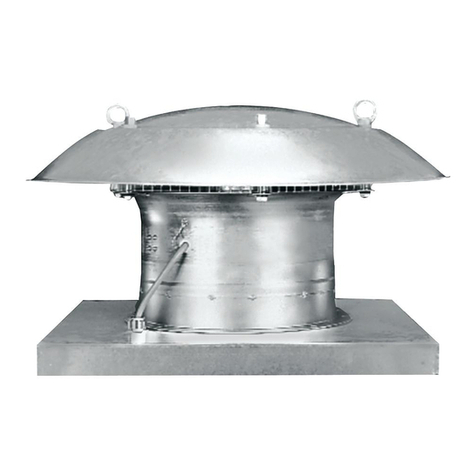
Maico
Maico EZD Series Mounting and operating instructions
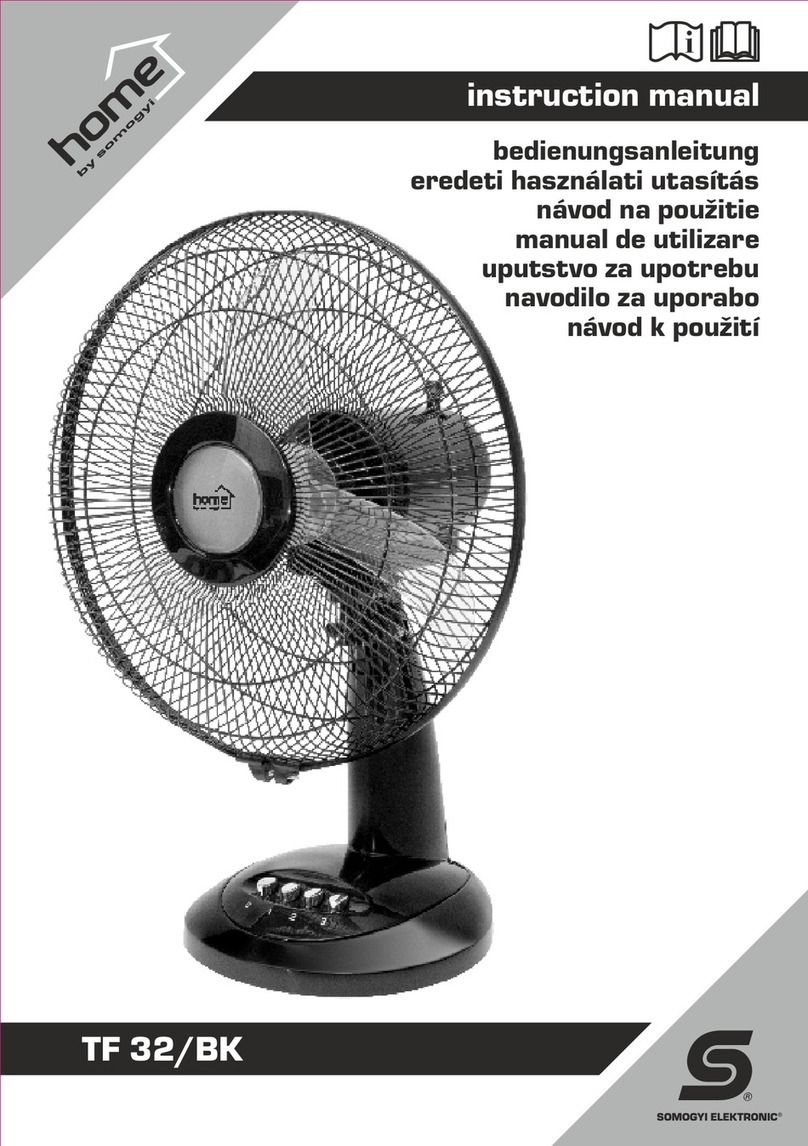
Somogyi Elektronic
Somogyi Elektronic home TF32/BK instruction manual

Emerson
Emerson BANFF CF720ORB00 owner's manual

bathstore
bathstore 41800041570 Fixing instructions

Derale
Derale DER-16749 Diagnostics guide
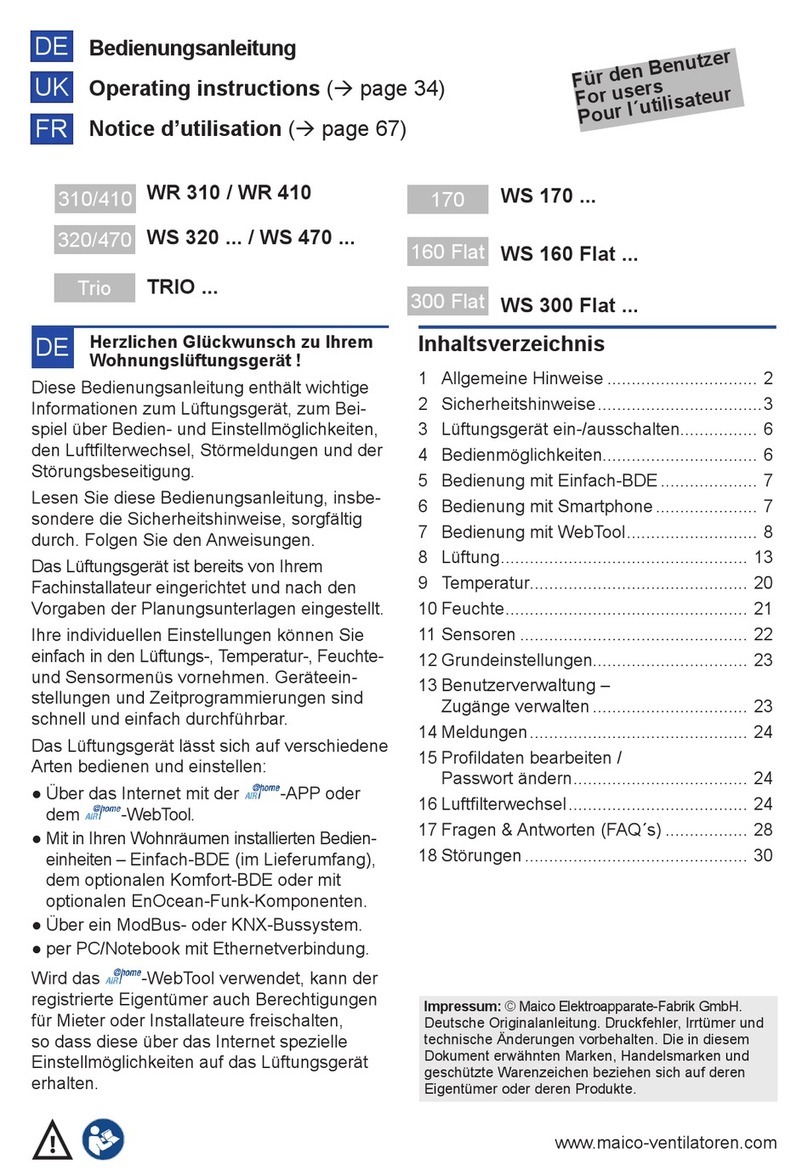
Maico
Maico WS 470 Series operating instructions

